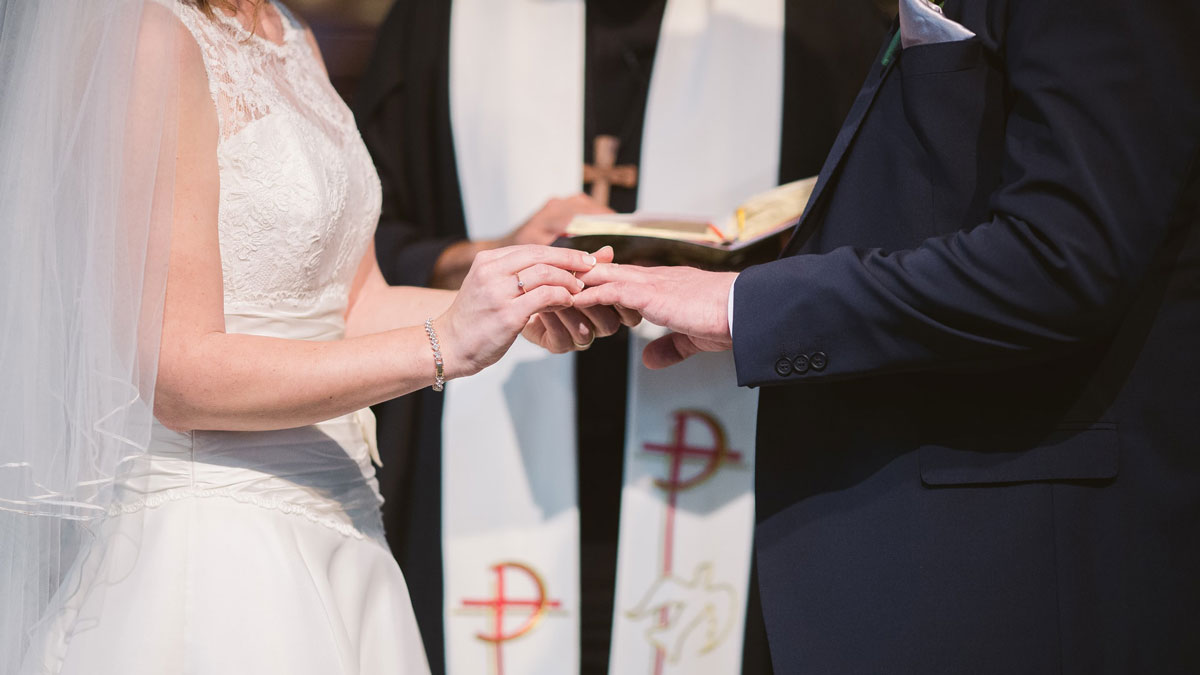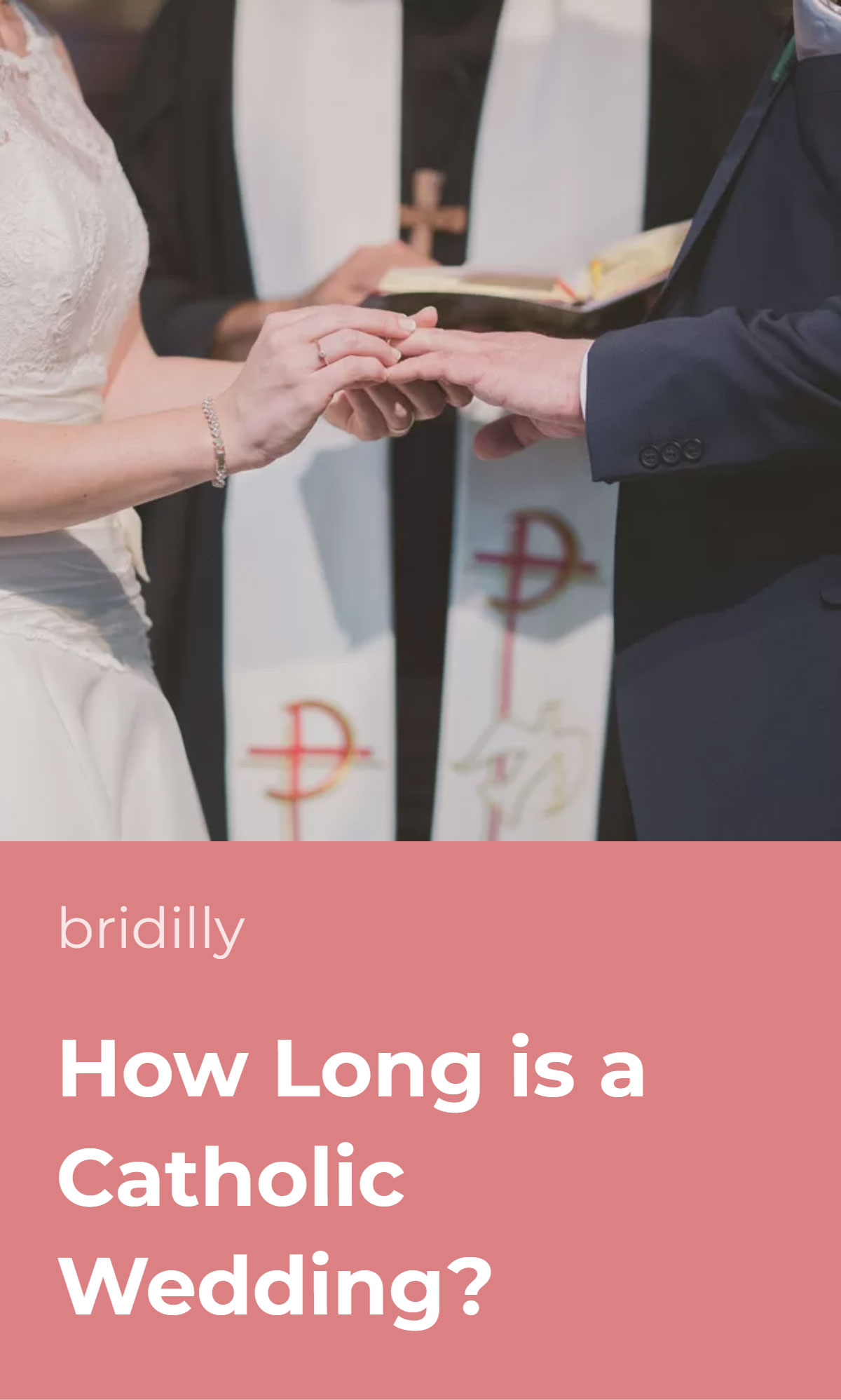The wedding day timeline can be tricky. If you opt for a religious ceremony, you should know how long is a Catholic wedding exactly.
The ceremony’s duration depends on a scope of factors, including the priest’s talking speed, chosen prayers, and newlywed vow length.
Some Catholic wedding ceremony elements are optional; others are mandatory. The couple can save about half-hour by refraining from optional parts, but frankly, the time shouldn’t be the deciding factor here.
A much better way to speed up the wedding ceremony to get to the reception on time is to ensure that everyone is organized and knows what to do.
Therefore, knowing what happens at a church wedding ceremony is essential for every couple to plan the day’s timeline accordingly.
Table of Contents [show]
The Procession
A traditional Catholic wedding starts with a procession. The groom and his best man enter the church from the side, followed by groomsmen and bridesmaids. The maid of honor enters the church alone.
Lastly, the bride’s father or another male family member walks the bride down the aisle and hands her over to the groom.
The length of the procession largely depends on the choice of music. Typically, an entire song is dedicated to the moment when the bride’s father walks her down the aisle and lasts about three minutes.
Sometimes, the bride and groom enter the church together, followed by the wedding party members, but this doesn’t affect the procession length drastically.
The procession altogether takes about five minutes, depending on the size of the church, the music, and, most importantly, how organized the wedding party members are.
To avoid slowing down the process, the bridesmaids and groomsmen should know precisely where to go and what to do.
The Invocation
The official ceremony begins with an invocation. The priest greets everyone attending the wedding and introduces the couple and the purpose of the gathering.
Sometimes, the priest asks whether anyone of the guests has reservations about the couple’s marriage, though this is optional.
Of course, the question is merely rhetorical, but someone replying would undoubtedly put the ceremony to a halt. Thankfully, this isn’t common, and the priest proceeds to read an opening prayer right after asking the question.
The length of invocation depends on the prayer chosen by the priest. On average, the invocation lasts about five minutes.
The Liturgy of The Word
The Liturgy of the Word is among the most symbolically significant parts of a traditional Catholic wedding and one of the longest. Nowadays, many couples refrain from the Liturgy of the Word to speed up the ceremony.
The Liturgy of the Word consists of six Old and New Testament readings, either by the priest or by family members and friends chosen by the couple.
After reading the first few passages from the Old Testament, the choir proceeds to recite or sing a Psalm. The priest then continues to recite New Testament passages, followed by Gospel acclamation encouraging everyone to stand up.
The couple sometimes has a choice between six opening prayers, but they don’t differ in length drastically.
The priest reads a passage from the Gospel, after which he will explain the meaning of the previous readings, focusing on the role of marriage in Catholicism – this part is known as a homily.
The Liturgy of the Word typically lasts about 20-25 minutes, depending on the priest’s reading speed and how he explains the readings during the homily. As a rule of thumb, the couple can refrain from it if one of them isn’t Catholic.
However, if both newlyweds are Catholic, the Liturgy of the Word is traditional. Still, the couple can skip it if their wedding timeline is tight.
The Celebration of Matrimony
The celebration of matrimony, also known as the Rite of Marriage, is the most important moment of the Catholic wedding ceremony when the bride and groom finally become a wife and husband.
The priest addresses the couple and asks about their freedom of choice, commitment, and other optional questions.
This is necessary to ensure that the marriage is consensual. The first part of the Rite of Marriage lasts only a couple of minutes at most.
The next part is the declaration of intent, when the couple proclaims their will to marry each other. It’s the moment when the partners say, “I do” and declare, “I, (name), take you, (name), for my lawful wife/ husband…”.
After the declaration of intent, the couple may exchange their vows. The vows are optional and may noticeably affect the wedding ceremony duration.
As a rule of thumb, the wedding vow duration should only be about a minute or two. However, some people opt for longer speeches lasting about five minutes. Furthermore, the wedding vow duration largely depends on the talking speed.
After the vow exchange or right after the declaration of intent, if the couple decides to skip the vows, the priest acknowledges and recognizes the statement of intent.
The priest then blesses the couple and wedding rings with holy water, and the couple exchanges their bands. Many couples wonder – are wedding rings mandatory at a Catholic wedding?
In fact, they aren’t. If you decide to skip the ring and vow exchange, you can easily save about 10-15 minutes. However, the tradition is undoubtedly meaningful and sentimental, so it’s worth the time for most couples.
After the blessings, the priest announces the couple’s marriage as official and proceeds with reading a prayer. The prayer is usually short and is followed by everyone singing Our Father.
Lastly, the couple gets on their knees, and the priest reads one more prayer for the newlyweds’ bountiful married life.
The Rite of Marriage duration varies. If the couple skips the ring and vow exchange or only reads a couple of sentences, it may take about 10-15 minutes. If the couple reads long vows, the celebration of matrimony may last up to 20 minutes.
Communion Rite
The Communion Rite is also known as the Liturgy of Eucharist and consists of three parts – the Offertory Song, the Eucharistic Prayer, and the Holy Communion.
The Offertory Song is short, about two minutes. While everyone sings, the altar is prepared for communion. The Eucharistic prayer only consists of several lines.
Before the Holy Communion, the priest reads another prayer and a Nuptial blessing. Everyone attending the wedding exchanges handshakes accompanied by the words “May peace be with you.”
Then, everyone sings Lamb of God and receives bread and wine. It must be noted that only Catholics participate in the Holy Communion, and its duration may vary depending on the attendee count.
On average, the communion lasts about 15-20 minutes. The Holy Communion is optional, and the couple can skip it altogether if one of them isn’t religious.
Blessings & Recessional
The Catholic wedding ceremony ends with final blessings and recessional. The priest blesses the new union, and everyone attending exits the church.
The recessional has a reverse order to the processional, starting with the bride and groom, followed by the maid of honor and best man, bridesmaids and groomsmen, and other guests.
Sometimes, the recessional includes ministers. Depending on how organized everyone is, the guest count, and the ministers, the ceremony’s ending part may take only a couple of minutes or up to 10 minutes.
A traditional Catholic wedding ceremony always takes place in the church because it’s a place designated for worship and prayer.
However, some couples invite the priest to a different location. In this case, the recessional isn’t necessary, but this doesn’t affect the ceremony duration much.
How Long Does the Ceremony Last in Total?
With so many optional rituals, you may be confused about how long a Catholic wedding ceremony lasts in total.
If you decide to skip the vow exchange, Holy Communion, and Liturgy of the Word, the entire ceremony may only take under 30 minutes.
On the other hand, if you opt for a full ceremony with a Mass, Communion Rite, and vow exchange, the wedding ceremony duration may exceed an hour.
The ceremony duration also depends on the guest count – the more people participate in the Holy Communion, the longer it lasts. Furthermore, more people will take more time to enter and exit the church.
If some of the guests aren’t Catholic and can’t partake in the communion, the couple may consider skipping it.
Celebrating the matrimony via communion can carry powerful symbolism, but if many attendees can’t participate, it can highlight division instead of unity. Guests who aren’t Catholic may simply not know how to act.
If you’re wondering whether you need a Mass, the main deciding factor should be your religious affiliations rather than the timeline. An extra half hour may seem excessive, but such a ceremony only happens once in a lifetime.
The same applies to ring and vow exchange. Don’t make your decision based solely on the timeline. If you feel like exchanging vows, do so and let everyone wait – it’s your special day, after all.
However, some couples feel awkward exchanging vows in front of everyone and do so in person or exchange letters.













No Comments Add one
Leave a Comment